We have chosen to make this article completely free for everyone. Please support our coverage by considering joining as a member. Scroll to the bottom for more information.
Main points on Saturday May 11th
-
Spain's coronavirus death toll has topped 26,251
-
Lockdown has been extended again until May 23rd
-
Half of Spain will enter into Phase 1 of de-escalation measures from Monday May 11th
-
Spain enters preparatory 'phase 0' on May 4th with loosening of some restrictions
-
Masks are mandatory on all public transport
-
Peak of the coronavirus crisis was reached on April 2nd
One of the worst-hit countries by the pandemic, Spain is enacting a four-phase transition to lift its strict measures to be completed by the end of June.
The health ministry announced Friday that around half of the country's 47 million population could enter the next phase from Monday.
But the Madrid region, which has recorded a third of the country's 26,299 coronavirus-linked deaths, was excluded.
It was rebuffed despite the regional government requesting the central administration relax the capital's lockdown, which led to a dispute over which Madrid's top health official reportedly resigned.
"We felt it was not appropriate to move to the next phase... This is not a race," said Health Minister Salvador Illa.
The second most-affected region Catalonia including its capital Barcelona will also have to wait, but it had not requested measures to be eased.
However many other parts of the country, such as southern city Seville or Bilbao in the north, will enter the new phase, which allows family or friends to meet in groups of up to 10, as well as travel within provinces.
In those regions, small shops will reopen without appointments and bars and restaurants can open on terraces -- with spaced seating.
Hotels will also be able to open, but will have to keep their communal areas shut.
READ MORE:
What's the latest on number of deaths?
Spain, which now has nearly 223,000 confirmed COVID-19 infections, has seen its death rate slow after entering the strict lockdown on March 14th.
It recorded 229 new deaths on Friday -- slightly higher than the previous day's 214.
The number has hovered around 200 over the last few days, far from the peak of 950 seen in early April.
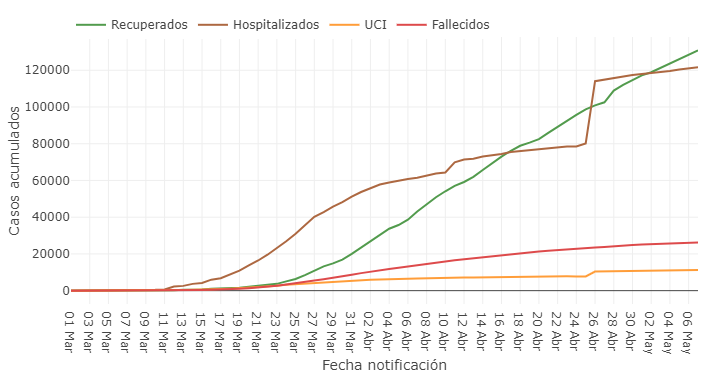
The overall number of hospitalizations (blue), admittance into ICU (yellow) deaths (red) and recoveries (green) are shown in the chart below, which reveals that the curve of the number of hospital admittances is flattening. Data: Ministry of Health.
Advertisement
Health chiefs believe the epidemic peaked on April 2 when 950 people died in one 24-hour period.
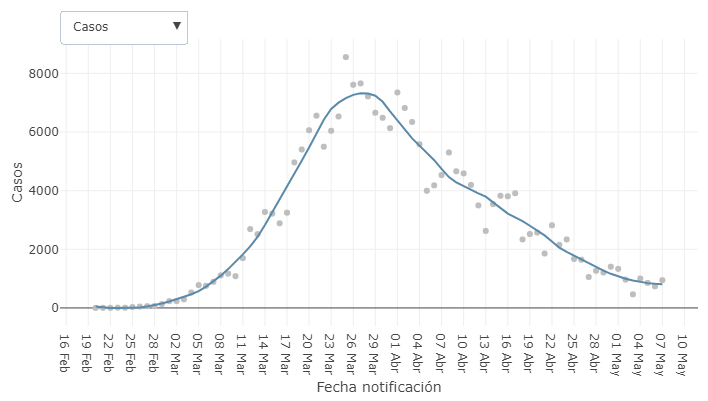
Spain began transitioning out of its strict virus lockdown on April 26th when it allowed children outside for an hour a day with the measure extended this weekend to adults who can now go out for a brief walk or exercise alone.
The government has said the restrictions will be gradually lifted in a four-phase process which will be completed by the end of June, with the country already engaged in the first preparatory stage.
On Monday, new rules went into effect on public transport, with police and civil protection officers handing out millions of masks at stations across the country to ensure commuters complied with the now-compulsory requirement.
"We remind you that it is obligatory to wear a mask, whether travelling on a train or anywhere inside the transport system," said a message over the loudspeakers at Sol station in central Madrid, which serves the metro and interurban trains.
On Monday, easing measures went into effect for some small businesses with premises no larger than 400 square metres (4,300 square foot) which can now receive customers with a reservation.
READ MORE:
"Today it's a bit chaotic with all the clients phoning for an appointment and trying to fit them all in," said Conchi Navarro, a 56-year-old hairdresser wearing a mask who has just opened her Barcelona salon.
Restaurants will also benefit from the changes. Until now, they have been allowed to prepare food for delivery, but from Monday they can also offer meals that customers can come and collect in person.
Spain is currently in the so-called preparatory phase zero and will enter stage one on May 11th when it will allow gatherings of up to 10 people within strict social distancing guidelines and the limited opening of bar terraces and street cafes.
Last week, the government began a seroprevalence study involving 60,000 people to collect information on the real number exposed to the virus through analysing blood test data.
Raquel Yotti, head of the Carlos III Health Institute, said the study would allow experts to get a real picture of "the number of people who have been in contact with the virus" and who have developed antibodies.
"It's important to know the spread of the virus at a national, regional and local level ... and to know if it happened at community level and how it may have spread within homes."
But the
true number of deaths in Spain may be higher than so far reported after records revealed those deaths that occured outside hospitals - in elderly care centres and private homes - were not being included in the official count.
How long will Spain's lockdown last?
Spain is in a state of alert, a measure which was declared on Saturday March 14th by Spain's Prime Minister Pedro Sánchez. It was extended by another fortnight until April 11th and then prolonged again on April 4th for another two weeks until April 25th.
It was extended yet again until May 9th but with the loosening on restrictions that will allow children to leave the house for the first time in almost six weeks from Sunday 26th April.
UPDATE: What you need to know about Spain's new rules for taking children outside during lockdown

Playgrounds and parks will remain closed until further notice. Photo: AFP
From May 2nd restrictions were loosened further to allow adults to go outdoors for the purposes of exercise.
READ MORE:
Pedro Sanchez unveiled what he called the "Plan for the Transition to the New Normal" which involves four phases of loosening restictions, each phase expected to last a minimum of two weeks.
The phases would be introduced from May 11th (apart from some islands in the Balearics and Canaries where Phase 1 would be in place from Monday May 4th) and would be rolled out province by province, depending on the evolution of the health crisis in each one.
Spanish PM Pedro Sanchezwon his battle to extend the state of emergency for another fortnight in a vote in parliament on Wednesday May 6th which means it won't be lifted until May 23rd.
In place since March 14th, the state of emergency has allowed the leftwing coalition government to order a strict confinement of nearly 47 million Spaniards under one of the tightest lockdowns in the world which are now being lifted in a four phase plan.
READ MORE:
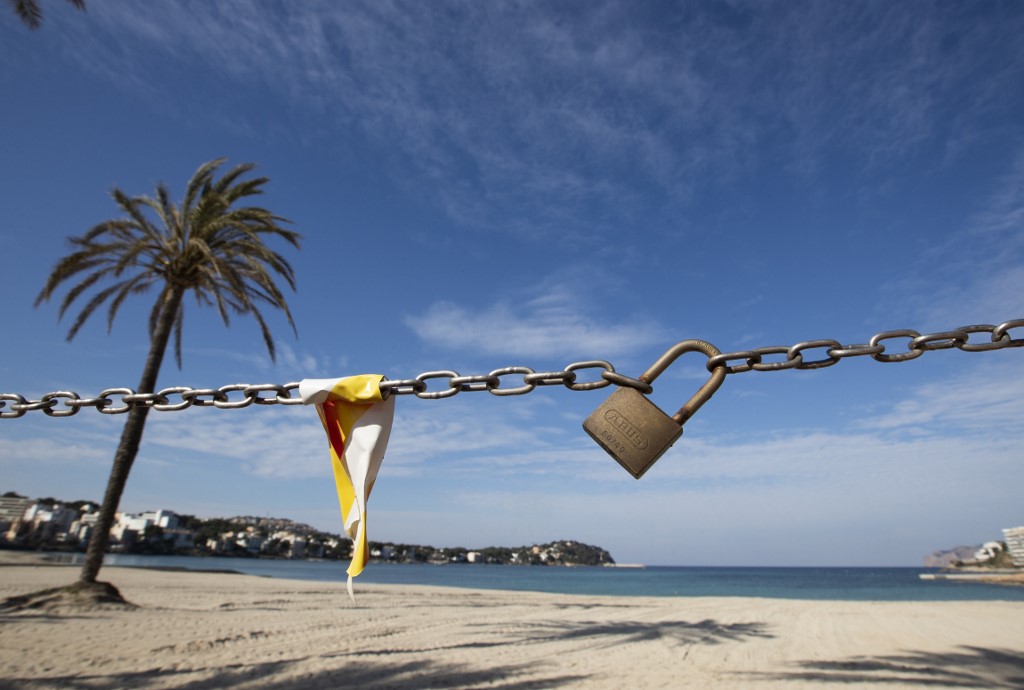
All Spain's beaches are currently closed until further notice. Photo: AFP
What am I allowed to do?
The rules are now determined by which phase your province has entered, with different restrictions in place for those in Phase Zero and Phase One.
Phase 1 will be rolled out province by province from Monday May 11th and will last a minimum of two weeks.
LATEST: Lifting lockdown: These are the provinces in Spain advancing to Phase 1
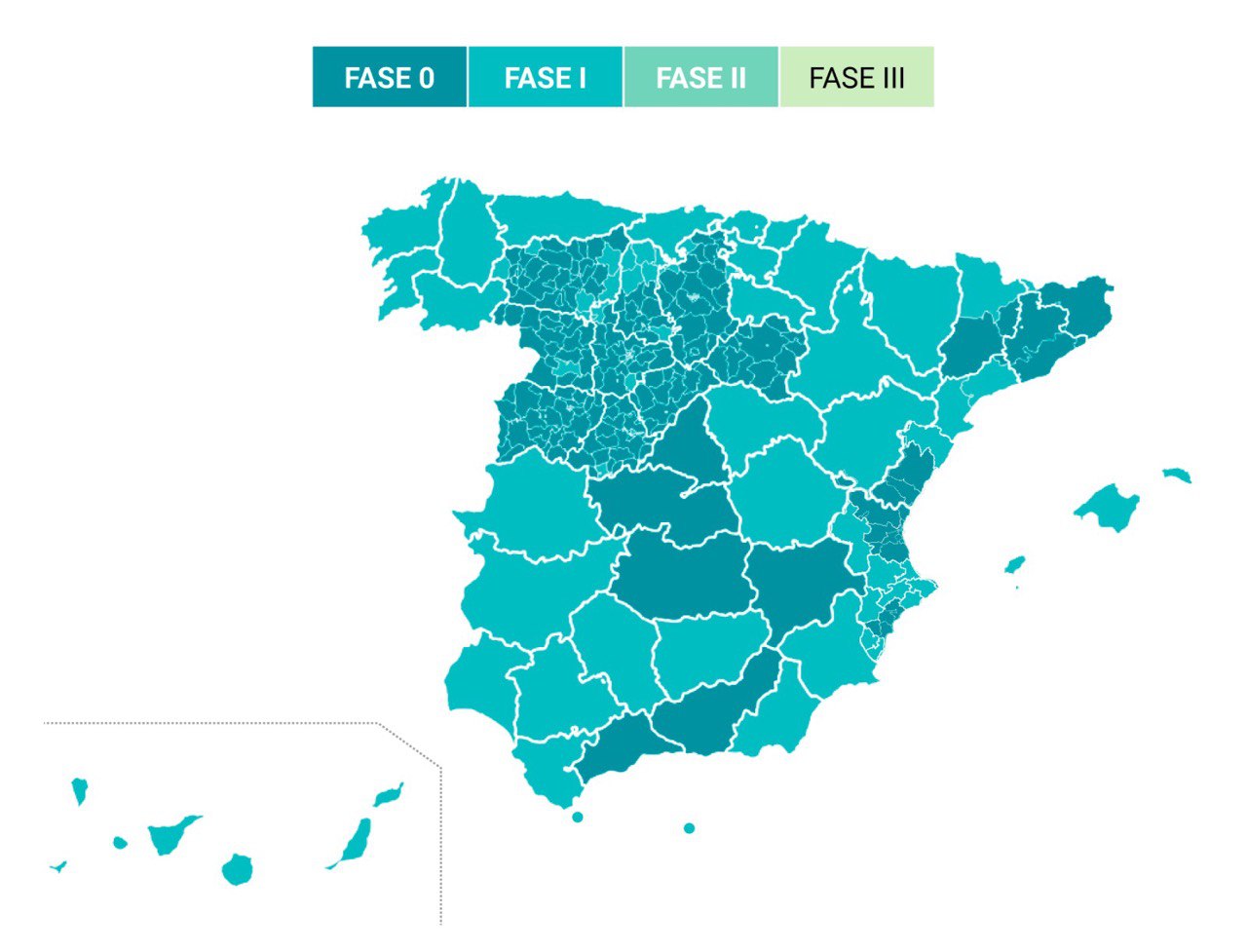
READ MORE:
A timetable is still in operation regardless of the Phase to allow adults to go outside and take exercise between 6am and 10 am and 8pm and 11pm, while children are allowed out for up to one hour between noon and 7pm. Older people and those considered vulnerable have the slots between 10am and noon and 7pm and 8pm.
Those caught breaching the restrictions of cuarentena (as lockdown is known in Spain) are liable to fines ranging from €100 up to €10, 400.
So far more than 70,000 fines have been issued and more than 6,300 arrests have been made.
There are also very strict rules about driving during lockdown with an automatic fine of €1,500 issued to those caught on the road travelling to a second home.
READ MORE:
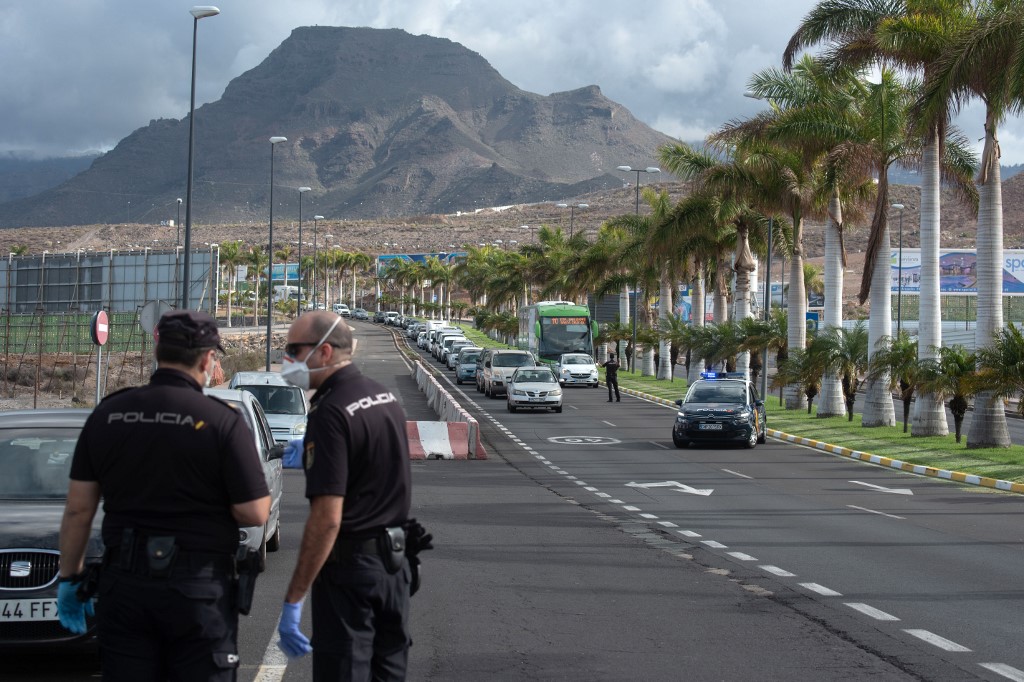
Road blocks are in place across Spain. Photo: AFP
Do I have to wear a face mask?
In line with the World Health Organisation's latest recommendations, Spain has been issuing citizens with face masks at public transport hubs for those who have to get to work and where it is not always possible to keep a secure distance of one or two metres.
However, face masks are not obligatory by law, as has been the case in northern regions of Italy where the virus has hit hardest.
Spain has in fact suffered from a huge shortage of face masks and protective equipment since the crisis reached pandemic proportions.
The vast majority of pharmacies have run out of them and medical personnel across the country has publicly denounced that they didn't have enough protective gear when helping Covid-19 patients.
Fortunately, a combination of donations and ingenuity on the part of local companies that have quickly turned their business model to face mask production has seen the availability of protective gear grow.
Advertisement
VIDEO: How air quality in Spain has improved since the coronavirus outbreak
Unemployment reaches record high
Spain's Social Security department recorded the biggest single drop in the number of contributors month on month in the since records began after 833,979 lost their jobs.
The pandemic "changed the trend" in unemployment figures for March, after only 2,857 workers filled jobless claims in the first 12 days of the month, the ministry said in a statement.
But the data doesn't include those people who have been made temporarily redundant, that is issued with an ERTE, because their employers will still be paying their social security contributions.
However, Spain registered a leap of 302,265 claims for unemployment benefit in March due to the "extraordinary impact" of the coronavirus pandemic on the economy, the labour ministry said Thursday April 2nd.
It is reportedly the biggest monthly increase on jobless claims on record in the eurozone's fourth-largest economy, which has been in a nationwide lockdown since March 14th to try to curb the spread of the virus.
April's total unemployment figures will be released at the start of May.
There have been several very frightening predictions about the impact the coronavirus lockdown will have on Spain economy, ranging from 8 percent drop in GDP by the IMF to 13.6 percent by the Bank of Spain.
Tourism and the hospitality sector are the worst affected, providing 12 percent of Spain's GDP and almost a fifth of jobs.
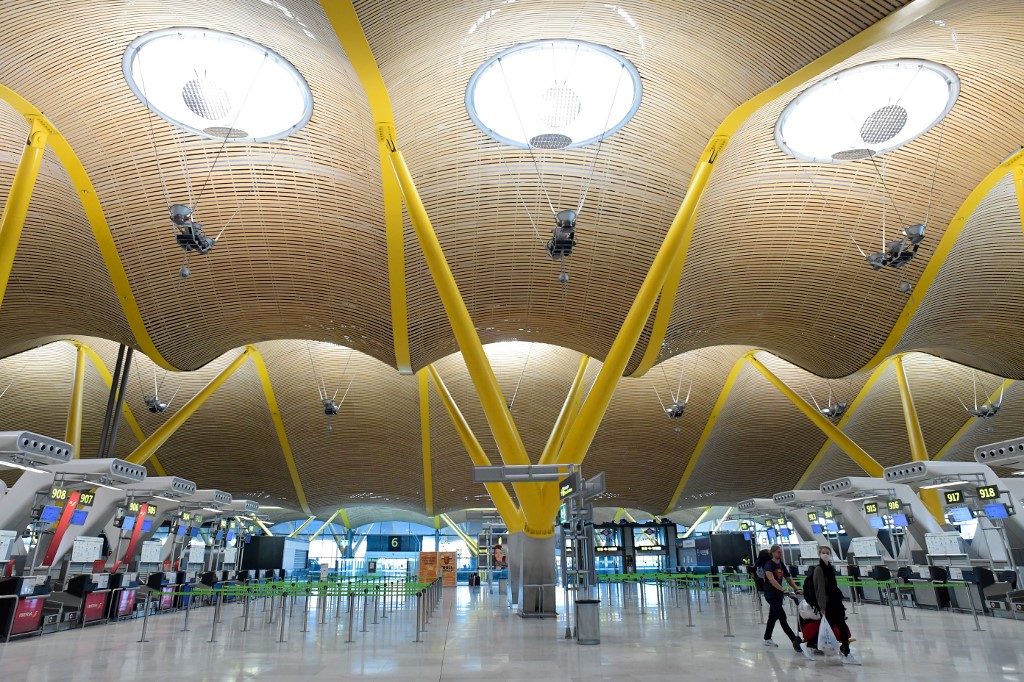
READ ALSO:
Advertisement
Spain helps tenants and the self-employed
The Spanish government has introduced a host of new measures to help those suffering economic hardships as a result of the coronavirus crisis.
With the economy in “hibernation” as the whole of Spain is placed in lockdown and many left unable to make ends meet at the end of the month, the cabinet approved emergency measures that include suspending rental payments and banning evictions during the state of emergency.
The cabinet approved a measure that will effectively ban the eviction of anyone who doesn't have a home to go to, while the state of emergency is in place and for the next six months after it is declared over.
It will also see an automatic extension of those rental contracts due to expire while state of emergency measures are in place.
"Housing is the trench from where people will resist the virus," said Social Affairs Minister Pablo Iglesias, whose hard-left Podemos governs in coalition with Prime Minister Pedro Sanchez's Socialists.
"For tenants, evictions will be suspended starting today and up to six months after the end of the state of emergency. Nobody can be evicted from their home."
Is travel to and from Spain still possible?
Spain's land borders have been closed since mid-March and only Spanish citizens and residents, cross-border workers and people with legitimate reasons are allowed to enter the country.
National and international air travel to and from Spain hasn't completely ground to a halt but the number of flights has been drastically reduced, with many countries and airlines outright blacklisting flights to Spain until due course.
If you're planning to travel to Spain you should consult your airline or tour operator to ensure the flights are going ahead, whether you've booked or not.
You will be expected to provide a legitimate reason for entering the country such as a primary home in Spain (which can be proved with a residency card) or other exceptional circumstances.
Hotels in Spain are now closed (except for those offering emergency accomodation) and all tourism-related activities are banned.
READ MORE:
!function(){"use strict";window.addEventListener("message",function(a){if(void 0!==a.data["datawrapper-height"])for(var e in a.data["datawrapper-height"]){var t=document.getElementById("datawrapper-chart-"+e)||document.querySelector("iframe[src*='"+e+"']");t&&(t.style.height=a.data["datawrapper-height"][e]+"px")}})}();
Advertisement
!function(){"use strict";window.addEventListener("message",function(a){if(void 0!==a.data["datawrapper-height"])for(var e in a.data["datawrapper-height"]){var t=document.getElementById("datawrapper-chart-"+e)||document.querySelector("iframe[src*='"+e+"']");t&&(t.style.height=a.data["datawrapper-height"][e]+"px")}})}();
 Photo: AFP
Photo: AFP
READ ALSO:
What are the symptoms?
Coronavirus belongs to the same family as colds and flu, and the symptoms are mostly similar (although coronavirus is not a flu) - like cough, headache, fatigue, fever, aching and difficulty breathing.
It is primarily spread through airborne contact or contact with contaminated objects.
Its incubation period is two to 14 days, with an average of seven days.
But it is very different to flu as is it considered far more contagious and the mortality rate could be as much as ten times higher.
How dangerous is it?
How ill people get with coronavirus varies, but the World Health Organisation says that only five percent of cases are considered critical, and 80 percent of infected people have only mild symptoms.Some 15 percent of cases see patients develop a serious condition that may need hospital treatment.
The majority of the people who have died were either elderly or had underlying health problems, and health authorities say everyone needs to practice good hygiene in order to protect this group. Visits to retirement homes and long-term care facilities are now banned.
But doctors and the government have repeatedly stressed that young people too can end up in critical condition.
READ ALSO:
What is the message to the public?
Stay home. Wash your hands often. Spain is under lockdown and that includes expats too.
How can I stay safe?
There is as yet no vaccine for coronavirus so Spanish health officials are advising people to practice good basic hygiene to keep themselves protected.
-
Wash hands your thoroughly and often with soap and water, especially after coughing and sneezing or before eating or it you have been touching surfaces that many other people will have touched such as on the Metro
-
Avoid touching your eyes, nose or mouth, especially with unwashed hands.
-
Cover your nose and mouth when coughing or sneezing. Cover your mouth with your elbow when coughing
-
Use disposable tissues and throw them away after use
-
Clean off surfaces with alcohol- or chlorine-based disinfectants.
READ MORE: Coronavirus: The everyday precautions to take if you're in Spain

What should I do if I think I have symptoms of the coronavirus?
If you develop a fever, cough or shortness of breath then you may have the coronavirus. Medical authorities in Spain no longer have the capacity to test every suspected case so unless you have underlying health conditions such as vulnerable immune system, diabetes, lung or heart problems you do not need to contact your doctor or medical authorities.
If you develop symptoms you must NOT go to a hospital but should quarantine yourself in the house away from other occupants of the house.
However if your symptoms worsen and you have real difficulty breathing you should call the coronavirus hotline that has been set up in your region in Spain.
If it is an emergency and an ambulance is needed then call the 112 medical emergency number and explain the symptoms.
Madrid: 900 102 112
Catalonia: 061
Aragon: 061
Balearic Islands: 061
Asturias: 112
Extremadura: 112
Melilla: 112
Andalucía:955 545 060
Castilla-La Mancha: 900 122 122
Comunitat Valenciana: 900 300 555
La Rioja: 941 298 333
Castilla y León: 900 222 000
Galicia: 900 400 116
Murcia: 900 121 212
Ceuta: 900 720 692
Navarra: 948 290 290
Canary Islands 900 112 061
Basque Country 900 203 050
Cantabria: 112 or 061
*****
Hi,
The Local's mission is to give our readers all the information they need about what's happening in Spain. We rely on paying members to do that, but we have chosen not to put any of our articles about the coronavirus behind our hard paywall, to help keep all of our readers informed. We believe it is the right thing to do at this time.
This means that new or occasional readers can read articles for free. On urgent need-to-know articles and official advice about coronavirus, we are also dropping the paywall completely. That includes this article.
We have received many comments from supportive readers asking how can they contribute. The best way is simply to sign up as a member. You can do that in just a few moments by clicking HERE.
We hope our paying members understand why we have chosen to make these articles about the coronavirus free for everyone, but if you have any questions, please let me know.
Kind regards,
Fiona,
Editor, The Local Spain
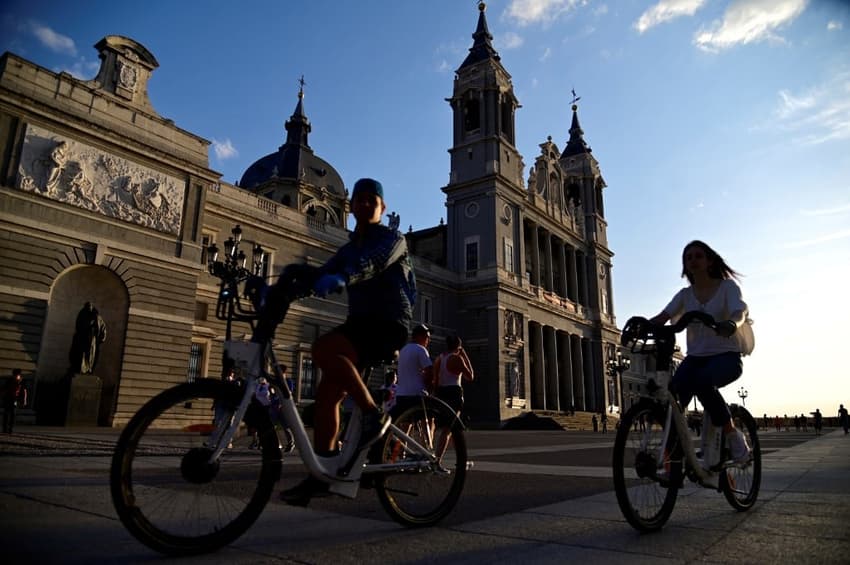









Join the conversation in our comments section below. Share your own views and experience and if you have a question or suggestion for our journalists then email us at [email protected].
Please keep comments civil, constructive and on topic – and make sure to read our terms of use before getting involved.
Please log in here to leave a comment.